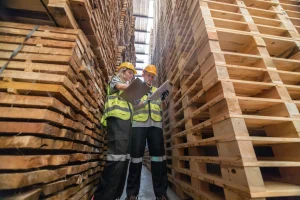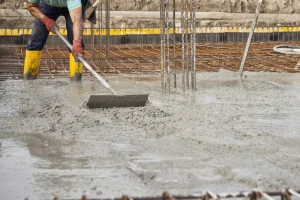If you export goods from the UK using wooden pallets or crates, you need to understand ISPM 15 heat treatment. This internationally recognised standard protects countries worldwide from pests and diseases that hide in untreated wood. Without proper treatment, your shipment could be rejected at the border.
What Is ISPM 15?
ISPM 15 stands for International Standards for Phytosanitary Measures No 15. In simple terms, it’s a set of rules about treating wood packaging material before it crosses borders. The International Plant Protection Convention (IPPC) developed these standards to prevent the spread of harmful organisms through international trade.
Since January 2021, all wooden packaging moving between Great Britain and the EU must meet ISPM15 international standards. Over 180 countries now require ISPM 15 heat-treated pallets for imports, including the United States, China, Australia, and all EU members.
Why Heat Treatment Works
Heat treatment kills pests by raising the wood’s core temperature high enough to eliminate any living organisms. The process targets wood-boring beetles, pinewood nematodes, and other destructive species that can survive for months inside timber.
Temperature Requirements
| Requirement | Standard Heat Treatment | Dielectric Heating |
|---|---|---|
| Core Temperature | 56°C minimum | 60°C minimum |
| Duration | 30 continuous minutes throughout the entire profile | 1 minute continuous |
| Wood Size | Any thickness | Less than 20cm wide |
The wood must reach 56 degrees Celsius at its core and maintain that temperature for 30 continuous minutes throughout the entire profile. This ensures the heat penetrates right through, killing any pests hiding deep inside the timber.
How to Heat Treat Pallets: The Process
Debarking
Before treatment begins, wood must be debarked. Bark can harbour pests and prevent heat from penetrating properly. Small pieces may remain if they’re less than 3cm wide or smaller than 50 square centimetres total.
Kiln Treatment
Wooden pallets are loaded into a specialised kiln that circulates hot air evenly. Operators monitor the core temperature using sensors because the surface heats faster than the centre. The treatment only starts when the core reaches 56°C.
Once there, the wood stays at that temperature for 30 minutes minimum. This holding time kills the pests. The kiln’s systems track this carefully to ensure the packaging materials are ISPM 15 compliant.
Cooling and Quality Checks
After treatment, wood cools naturally. The process also removes moisture, making the pallets lighter and more durable. Treated wood undergoes inspection, and facilities keep detailed records for traceability.
ISPM 15 Marking Requirements
After successful heat treatment, pallets receive an official mark. This internationally recognised stamp proves the wood meets standards. You don’t need certificates – the mark is all the proof customs needs.
The mark includes:
- The IPPC logo
- A two-letter country code (GB for Great Britain)
- A unique registration number
- Treatment code (HT for heat treatment)
Example: GB-1234-HT
The mark must be clearly visible and legible. If customs officials cannot read it, they’ll treat the pallet as non-compliant.
Consequences of Non-Compliance
Not following ISPM 15 standards can cause serious problems:
- Shipment rejection at borders
- Quarantine delays lasting weeks
- Financial penalties in some countries
- Destruction of entire shipments
- Damaged business relationships
The UK Government’s wood packaging material guidelines confirm that border officials conduct risk-based inspections on any wood packaging material to ensure it meets requirements.
Reusing ISPM 15 Compliant Pallets
Once a pallet is heat-treated and properly marked, you can reuse it multiple times. The stamp stays valid unless you modify the pallet.
However, if you repair a pallet by adding new wood, you must arrange for re-treatment and re-marking. The new timber hasn’t been through heat treatment, making the entire pallet non-compliant.
Watch for signs of pest infestation in reused pallets. If customs spot evidence of insects, they may order treatment or destruction regardless of the mark.
Benefits of Heat-Treated Wooden Pallets
Heat treatment offers advantages beyond meeting regulations:
- Safer handling – Free from harmful organisms
- Better durability – Lower moisture means stronger pallets
- Reduced weight – Drier wood lowers freight costs
- No chemical residues – Unlike fumigation methods
- Environmentally friendly – No harmful chemicals used
Many food and pharmaceutical companies specifically request heat-treated packaging materials to avoid chemical contamination risks.
Choosing Your Supplier
When selecting ISPM 15 heat-treated pallets, look for suppliers who:
- Are registered with the UK Wood Packaging Material Marking Programme
- Have proper Forestry Commission certification
- Maintain detailed treatment records
- Conduct regular facility assessments
- Provide clearly marked pallets with legible stamps
Working with experienced suppliers like CM Pallets ensures your wooden packaging meets all international standards for phytosanitary measures, helping your exports clear customs smoothly.
Frequently Asked Questions
How long does ISPM 15 heat treatment take?
The actual treatment takes at least 30 minutes once the wood’s core reaches 56°C. However, the complete process – including heating the kiln, treatment time, and cooling – typically takes several hours. Order heat-treated pallets in advance rather than expecting same-day service.
Can I heat-treat pallets myself?
You’d need to join the UK Wood Packaging Material Marking Programme and register with the Forestry Commission. Your facility would require six-monthly assessments. For most businesses, it’s more practical to purchase pre-treated pallets from certified suppliers.
Does heat treatment weaken wood?
No. Heat treatment actually improves wood’s structural properties by removing moisture. It reduces warping and cracking risk. The wood becomes more stable and stronger than untreated timber when done correctly at specified temperatures.
Do all countries accept heat treatment?
The vast majority of countries requiring ISPM 15 compliance accept heat treatment. It’s the most widely recognised method globally. However, always check specific requirements for your destination country, as some may have additional regulations.
Protect Your Exports Today
Understanding how ISPM 15 heat treatment works helps you make informed decisions about your export packaging. The process eliminates pests whilst preserving wood quality, making international trade safer for everyone.
By choosing properly heat-treated wooden pallets, you protect your business from costly delays and rejections whilst helping to prevent the spread of harmful organisms worldwide.
Need ISPM 15-compliant pallets? Work with experienced suppliers who understand the regulations and deliver quality, certified products with 24-hour guaranteed delivery.




